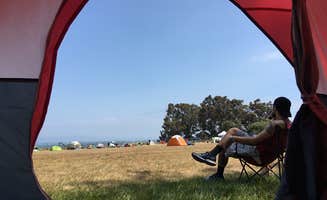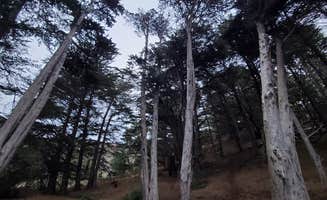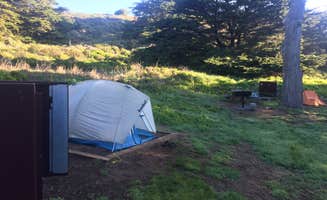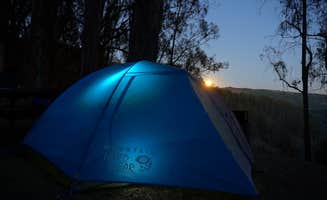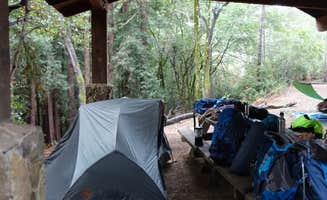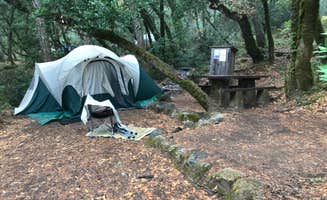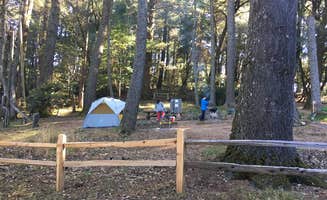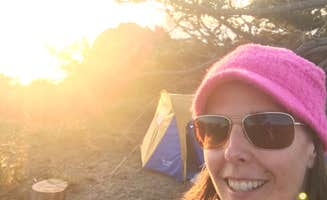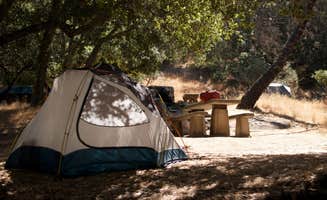Camping spots near Berkeley, California offer a mix of coastal and forested experiences within an hour's drive. The region sits where the Berkeley Hills rise to elevations between 1,200-1,900 feet, creating microclimates that can shift dramatically from foggy coastlines to sunny inland areas. Many campgrounds in this region stay open year-round, though winter camping often comes with temperatures that drop into the 40s at night.
What to do
Hike alongside creeks: At Samuel P. Taylor State Park, there's a paved path that "runs for at least a mile or so along the creek, that used to be the old railroad line through that area," according to one camper. The park features "informational signs all over the place providing historical or ecological information."
Explore island wilderness: Angel Island State Park offers unique hiking opportunities. "The island itself is about a 5 mile hike from one end to the other with a very modest elevation gain so it's definitely worth doing," notes one visitor. Another adds, "You can hike throughout the island to with great bay views and bridge views on all sides. Then there is the history there from the Civil War sites to the immigration sites."
Catch views of San Francisco: For urban skyline views, visit H. Dana Bower Rest Area. One camper explains it has an "excellent view of the city and the bridge" and another recommends to "bring binoculars and your good camera. Bolinas, Stinson, The Farallon Islands, fishing boats, the night sky, raptors, seals, all manner of water fowl…that's why you're here."
What campers like
Stargazing opportunities: The dark skies above Mount Tamalpais provide excellent star viewing. One visitor to Pantoll Campground reported "a beautiful place with lots of stars which my group LOVED!!!" The campground's location away from major light pollution creates favorable conditions for astronomy enthusiasts.
Quiet weekday camping: For those able to visit outside peak times, weekdays offer much more solitude. A camper at Steep Ravine Campground shared, "We've been lucky enough to score one of these cabins twice by checking in every so often to see if someone cancelled a reservation." Another noted, "I had the flexibility to go during the week and luckily there were permits available."
Wildlife viewing: The diverse ecosystems support abundant wildlife observation opportunities. A visitor to Anthony Chabot Regional Park reported "lots of birds and wildlife—beware says the sign...all the signs, but I mostly only saw turkeys and a few water birds." Another mentioned seeing "deer, turkeys, owls" and that "the eucalyptus groves make the air smell wonderful."
What you should know
Raccoon management: Multiple campgrounds report persistent raccoons. At Kirby Cove Campground, one camper warns: "I've been camping my whole life and NEVER have I seen raccoons so persistent. Not aggressive. Just persistent. And fearless. They. Will. Not. Leave. You. Alone. From like 5:00 pm to 8:00 pm they will stalk your site looking for ANY unsecured food."
Poison oak awareness: Many trails contain poison oak, especially in less maintained areas. A camper at Anthony Chabot Regional Park advised, "If you walk the single track trails with your dogs, you'll be spending some quality time with them later picking off ticks. Be aware of the poison oak as well."
Temperature fluctuations: Coastal fog creates dramatic temperature drops, especially at night. A visitor noted: "The cool moist ocean fog comes in and blankets the area in the evenings, which can really cool it down" and another advised, "One thing to note, the night is COLD up this way, and mere miles will cover several different weather systems. Bring layers."
Tips for camping with families
Visit small animal farms: Tilden Regional Park offers attractions beyond camping. A reviewer recommends "taking the kids to Tilden's Little Farm (bring your own carrots, kale and lettuce)" which provides an educational experience for children interested in farm animals.
Choose family-friendly sites: Look for designated family areas with appropriate amenities. One camper reported Anthony Chabot Regional Park has "great natural area that is so conveniently located in the Bay Area. There is an extensive network of trails accessible from the campground."
Pack for fog horn noise: At coastal sites, prepare for nighttime noise. A camper at Bicentennial Campground warns: "At night the fog horns on the bridge are very loud and very close, so bring something to cancel the noise," which is especially important for light-sleeping children.
Tips from RVers
Site selection for larger vehicles: Some parks have limited space for bigger RVs. At Marin RV Park, a visitor advises: "It's very tight spacing, no privacy in between lots so be prepared and skilled if you have a bigger rig. My 34 foot trailer took some time to get in." They also suggest bringing "extra hose" because "they don't have traditional posts where you would expect the water to be."
Consider urban-adjacent options: RVers seeking convenient city access should consider strategic locations. One camper noted about Marin RV Park: "Drive in, park and then walk to all the sights you want to see in San Francisco. A short 10 minute walk from the RV park is the ferry that will drop you off downtown San Francisco."
Check hookup availability: Full hookups are limited in the area. A visitor to Samuel P. Taylor State Park observed that "Level pad for camp trailers. Fire pits updated and bbq on every site," but noted the park is "a bit too tight for large trailer or RV camping (unless you are an expert at maneuvering through tight spaces)."


